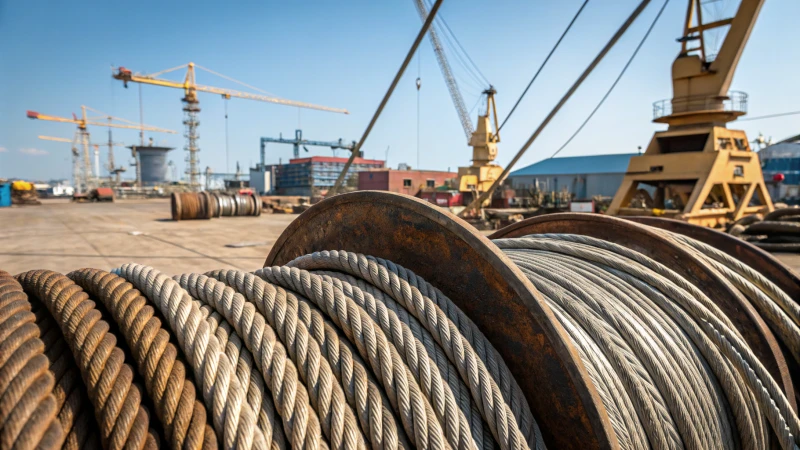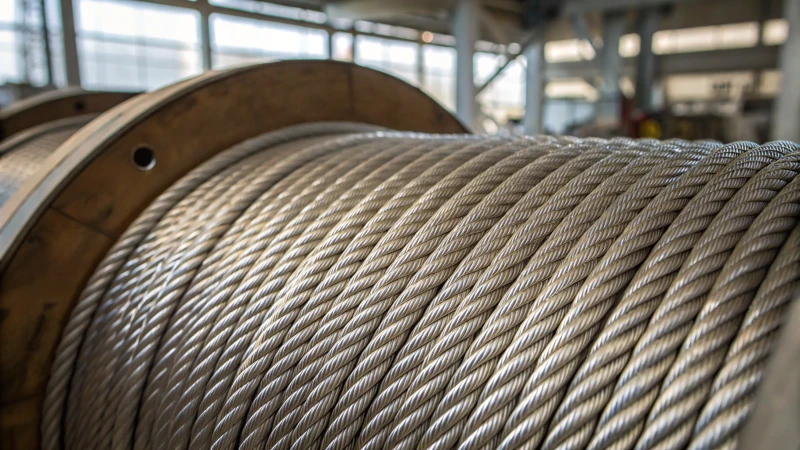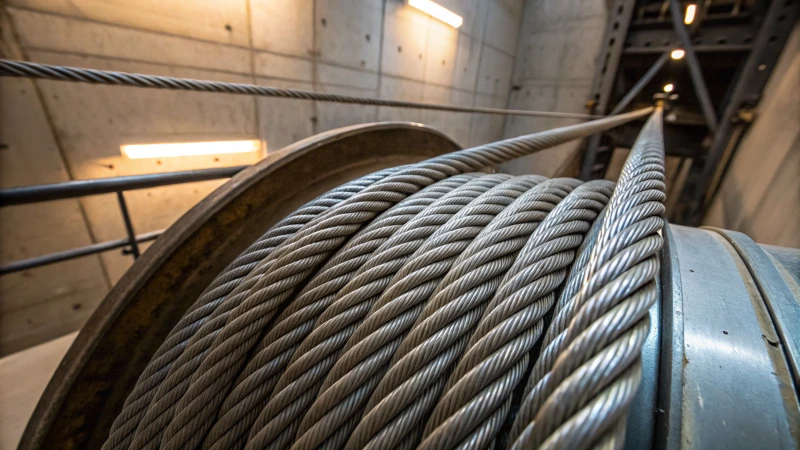
Ever wondered what keeps those massive elevators moving smoothly up and down skyscrapers?
Steel wire ropes are your best bet for elevators with high-load capacity because they blend incredible tensile strength, durability, and resistance to corrosion. This perfect mix ensures elevators run safely and efficiently, even in tough conditions.
I remember the first time I stood beneath a towering skyscraper, marveling at the elevators whisking people effortlessly to dizzying heights. It dawned on me how crucial the right choice of components is in ensuring safety and performance. While steel wire ropes might seem like just another technical detail, they're the unsung heroes of vertical transportation.
These ropes aren't just about strength; they're about peace of mind. You see, when I learned about their incredible tensile strength—somewhere around 1770 MPa, potentially reaching 2000 MPa with high-strength alloys—I realized how they provide that much-needed reliability. Their construction, often a 6×36 arrangement, offers the perfect balance of flexibility and strength, essential for handling high loads without compromising on safety.
And it doesn't stop there. Coatings like stainless steel or galvanized finishes add an extra layer of protection against corrosion, extending the service life significantly—up to 25% longer in corrosive environments compared to standard carbon steel ropes. This means fewer replacements, less downtime, and more peace of mind for people like me who rely on their unwavering performance day in and day out. It's these little yet mighty innovations that keep our modern world moving smoothly.
Steel wire ropes are corrosion-resistant.True
Steel wire ropes have coatings that protect against rust, increasing longevity.
Steel wire ropes lack flexibility for elevators.False
Steel wire ropes are designed to be flexible, aiding smooth elevator operation.
What Makes High-Load Elevator Steel Wire Ropes Stand Out?
Imagine standing at the base of a skyscraper, looking up at the elevators zipping silently skyward. What ensures their smooth, safe journey? The unsung heroes are high-load elevator steel wire ropes.
High-load elevator steel wire ropes need a minimum tensile strength of 1770 MPa, with high-strength alloys reaching beyond 2000 MPa. The optimal design is 6×36, balancing flexibility and strength. Coatings like stainless or galvanized provide essential corrosion resistance.

Tensile Strength: The Backbone of Performance
When I first learned about tensile strength, it reminded me of the time I tried to hang a heavy picture frame with a flimsy nail. Needless to say, it didn't end well. Just as that picture needed a sturdy nail, high-load elevator ropes require robust tensile strength. Starting at 1770 MPa for typical steel, they can soar beyond 2000 MPa with high-strength alloys. This strength ensures they can carry hefty weights safely, much like those skyscraper elevators I used to watch in awe.
Construction: Balancing Flexibility and Strength
Choosing the right construction for these ropes is like picking the perfect pair of jeans—flexible yet strong enough to last. The 6×36 construction stands out in this regard. Picture six strands with 36 wires each, woven together to create a robust yet adaptable structure perfect for elevator systems1. It's like finding that perfect balance between comfort and durability.
Coating Options: Protection Against Corrosion
Living near the coast taught me a thing or two about rust. My bike, exposed to salty air, would rust if not cared for. Similarly, these ropes benefit from stainless or galvanized coatings that fend off corrosion, ensuring longevity even in damp environments. High-strength stainless steel ropes can last up to 25% longer in corrosive conditions than their carbon steel counterparts.
| Specification | Details |
|---|---|
| Tensile Strength | 1770 MPa - 2000 MPa+ |
| Construction | 6×36 |
| Coating | Stainless/Galvanized |
Standards and Compliance
Adhering to international standards like ISO and ASME isn't just a suggestion—it's a necessity. These standards are like the unwritten rules of friendship, ensuring safety and reliability in heavy-duty usage. Understanding these standards is crucial for professionals like John from construction2, who need assurance that their projects won't face unexpected hitches.
Key Considerations for Procurement Professionals
For those in procurement, like my friend Emma who works in mining equipment procurement (PLACEHOLDER_K1L2M3N4O5), finding reliable suppliers is akin to choosing trustworthy friends. They need detailed specifications and solid support. Emma knows that the ropes must endure extreme conditions without faltering.
Selecting high-load elevator steel wire ropes means diving deep into technical specs to ensure they meet performance and safety needs. Suppliers should provide clear data sheets so buyers can make informed choices. A wise selection means improved efficiency and safety in elevator systems—no one wants costly downtimes or replacements.
Focusing on these specifications allows procurement officers to choose the most suitable ropes, ensuring reliability and longevity in their applications. It's like choosing the right tool for a job—precision and quality lead to success.
High-load elevator ropes must meet ISO standards.True
ISO standards ensure ropes are manufactured to withstand heavy-duty usage.
The 6×36 construction is not suitable for high-load applications.False
The 6×36 construction balances flexibility and strength, ideal for high-load use.
How Does Construction Type Affect the Performance of Steel Wire Ropes?
Have you ever wondered why some steel wire ropes perform better than others in tough conditions? The secret often lies in their construction type.
The type of construction of steel wire ropes plays a crucial role in their performance, impacting their flexibility, strength, and resistance to environmental factors. Different constructions are tailored to specific applications, balancing load capacity with endurance.

Understanding Different Wire Rope Constructions
When I first started working with steel wire ropes, I was amazed at the sheer variety of constructions available. Each type serves a unique purpose, much like how choosing the right tool can make all the difference in a DIY project. Think of steel wire ropes as a bundle of tiny wires twisted together, kind of like how strands of spaghetti form a solid handful when cooked. The way these strands are twisted defines their core characteristics. A 6×36 construction, for example, consists of six strands with 36 wires each, giving it a balance between flexibility and strength.
Flexibility and Strength Balance
I remember a project where flexibility was non-negotiable. We needed ropes that could bend and twist without compromising on strength, like a gymnast who combines grace with power. In such cases, ropes with more wires per strand, like the 6×36 construction, are ideal. They offer high flexibility3 but may trade-off some strength compared to constructions like 6×19. It's all about finding that sweet spot where flexibility meets robustness.
| Construction Type | Number of Strands | Number of Wires per Strand | Flexibility | Strength |
|---|---|---|---|---|
| 6×19 | 6 | 19 | Moderate | High |
| 6×36 | 6 | 36 | High | Moderate |
Core Types and Their Impact
Then there's the core of the rope—it's like the backbone that supports everything else. A fiber core adds flexibility, making it suitable for light-duty applications4 where agility is key. On the other hand, a steel core offers durability and heat resistance, perfect for heavy-duty tasks like crane operations. It's like choosing between a comfy pair of sneakers or sturdy boots, depending on the terrain.
Coatings and Environmental Resistance
In corrosive environments, I can't emphasize enough how important coatings are. Galvanized or stainless steel coatings can extend a rope's service life by up to 25%, particularly in marine settings where saltwater poses a relentless threat. Imagine how much longer your favorite outdoor gear lasts when it's treated for weather resistance—steel wire ropes work on a similar principle.
Application-Specific Considerations
Selecting the right rope isn't just about construction type; it's about understanding the application. For example, in high-load elevators, ropes with tensile strengths of at least 1770 MPa are crucial. In mining operations, the ropes must resist wear and corrosion effectively—much like picking the right vehicle5 for your journey; whether it's off-roading or highway cruising, each has its specific needs.
Understanding these elements helps me guide procurement managers and engineers toward making informed decisions. By ensuring the ropes used meet both performance and safety standards efficiently, we can tackle any project with confidence.
6×36 wire ropes are more flexible than 6×19 ropes.True
The 6×36 construction has more wires per strand, increasing flexibility.
Steel core ropes are less durable than fiber core ropes.False
Steel cores enhance durability and strength compared to fiber cores.
Why Is Corrosion Resistance Vital for Elevator Wire Ropes?
Imagine stepping into an elevator, trusting it to carry you safely, only to wonder about the integrity of those unseen cables.
Corrosion resistance in elevator wire ropes is crucial because it prevents structural degradation, ensuring both safety and longevity. Materials like stainless steel or galvanized coatings are key to enhancing this resistance.

The Role of Corrosion Resistance in Elevator Safety
Elevator wire ropes are like the invisible threads holding up our daily lives, quietly bearing the weight of each journey between floors. When I first learned about how corrosion can weaken these lifelines, it was a revelation. Imagine the potential consequences of those ropes failing—it's a stark reminder of why corrosion resistance6 is so essential.
How Corrosion Affects Wire Ropes
I remember the first time I saw a rusted cable; it was a chilling sight, realizing that moisture and environmental elements had silently compromised its strength. For elevator ropes, corrosion means more than just aesthetic damage; it directly reduces their load-bearing capacity and increases the risk of accidents—a risk that's unacceptable given how often elevators are used.
| Factor | Effect |
|---|---|
| Moisture | Accelerates rust formation |
| Salt (in coastal areas) | Enhances corrosive reactions |
| Temperature Fluctuations | Causes expansion and contraction, leading to fatigue |
Materials That Combat Corrosion
Choosing the right materials can be a game-changer. Stainless steel ropes, with their chromium protective layer, remind me of a knight's armor—a steadfast defense against rust. Galvanized coatings offer another layer of security, like a guardian sacrificing itself for the greater good.
- Stainless Steel: Known for its durability and resistance to various environmental factors.
- Galvanized Ropes: Offer an economical solution with good corrosion resistance7.
Real-world Applications and Benefits
In the towering world of high-rise buildings, reliable elevators aren't just a luxury—they're a necessity. Corrosion-resistant ropes ensure smooth operation over time, cutting down on maintenance costs and boosting passenger safety. It's a no-brainer why building managers prefer them, just like how I prefer my coffee strong and dependable.
Testing and Standards for Corrosion Resistance
Understanding testing procedures for these ropes feels like reading the safety manual before a flight—it's all about ensuring everything goes smoothly. These rigorous tests replicate real-world conditions to assess how well ropes withstand corrosive environments.
Benefits of Regular Testing
- Safety Assurance: Identifies potential weak points before they become hazards.
- Cost Efficiency: Helps in planning maintenance schedules effectively.
- Compliance: Ensures that products meet industry safety standards through thorough testing procedures8.
For anyone in procurement or maintenance like myself, knowing about these materials and testing processes is invaluable. It’s about making informed decisions that keep safety and performance at the forefront, much like choosing the right ingredients for a recipe that can't afford to fail.
Corrosion reduces elevator rope load capacity.True
Corrosion leads to material loss, weakening the rope's ability to bear loads.
Stainless steel ropes are unaffected by moisture.False
While resistant, stainless steel can still corrode in harsh environments.
How Do Steel Wire Ropes Enhance Safety in Elevator Systems?
Ever wondered how those steel cables in elevators keep us safe? It’s a fascinating blend of engineering and reliability.
Steel wire ropes boost elevator safety with their impressive tensile strength, flexibility, and corrosion resistance. These characteristics ensure dependable performance under various conditions, minimizing the risk of mechanical failures.

Understanding the Construction of Steel Wire Ropes
I've always been intrigued by how such a simple-looking thing like a steel rope can hold so much weight without snapping. The secret lies in its 6×36 construction9. Picture this: six strands, each with 36 wires, all twisted around a core. It's like a powerful dance of metal that combines flexibility with incredible strength. This means that the rope can easily bend over sheaves and pulleys but still hold its ground under pressure.
Key Material Properties
There’s something almost magical about the materials used in these ropes. Take standard carbon steel, for example—it boasts a tensile strength of 1770 MPa. But when I think of high-strength alloy steels, which can exceed 2000 MPa, I’m reminded of the times I've seen them in action under harsh conditions. In places where corrosion is a menace, stainless steel or galvanized ropes are preferred for their added resistance, giving them a service life that can extend by up to 25%.
| Property | Standard Steel | High-Strength Alloy |
|---|---|---|
| Tensile Strength | 1770 MPa | 2000+ MPa |
| Corrosion Resistance | Moderate | High |
Safety Features and Testing
I remember being awestruck during my first visit to a testing facility. Watching those steel wire ropes undergo rigorous testing was like watching a well-rehearsed safety drill. These tests include load-bearing checks and corrosion resistance analysis10, which help catch any wear and tear before they become problems. Regular inspections are a must—after all, nobody wants to hear a scary creak when they’re halfway up a skyscraper!
The role of steel wire ropes in ensuring elevator safety is paramount. Their robust construction not only handles immense loads but also maintains flexibility for smooth operations. And for those of us who worry about sudden failures, their design is crafted to prevent just that, offering peace of mind every time we step inside an elevator.
Incorporating advanced materials and designs adds another layer of reliability. For instance, plastic coatings provide an extra shield against the elements, ensuring top performance even in the harshest conditions.
Steel wire ropes in elevators have a 6×36 construction.True
The 6×36 construction balances flexibility and strength, crucial for elevator safety.
Standard carbon steel ropes offer higher tensile strength than alloy steels.False
High-strength alloy steels exceed 2000 MPa, surpassing standard carbon steel's 1770 MPa.
Conclusion
Steel wire ropes are essential for high-load elevators, offering superior tensile strength, flexibility, and corrosion resistance to ensure safety and reliability in vertical transportation systems.
-
Explore how 6×36 construction benefits elevator systems with its flexibility and strength. ↩
-
Understand the importance of ISO standards in ensuring safety and reliability. ↩
-
Understanding flexibility benefits can help in selecting the right rope for dynamic applications. ↩
-
This comparison aids in deciding between flexibility and strength for specific tasks. ↩
-
Finding marine-specific ropes helps ensure longevity and safety in corrosive settings. ↩
-
Understanding structural integrity helps identify how corrosion impacts rope performance and safety. ↩
-
Exploring material differences aids in selecting the best option for corrosion-prone environments. ↩
-
Learning about testing methods ensures compliance with safety standards and maintenance planning. ↩
-
Learn how the 6×36 construction offers optimal strength and flexibility for heavy-duty applications. ↩
-
Explore testing methods that ensure steel wire ropes maintain integrity in corrosive environments. ↩

